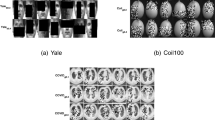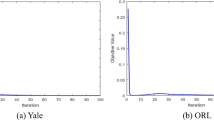Abstract
The traditional linear discriminant analysis (LDA) is a classical dimensionality reduction method. But there are two problems with LDA. One is the small-sample-size (SSS) problem, and the other is the classification ability of LDA is not very strong. In this paper, by studying several common methods of LDA, an implicit rule of the criterion of LDA is found, and then a general framework of LDA combined with matrix function is presented. Based on this framework, the polynomials are used to reconstruct the LDA criterion, and then a new method called polynomial linear discriminant analysis (PLDA) is proposed. The proposed PLDA method has two contributions: first, it addresses the small-sample-size problem of LDA, and second, it enhances the distance of the between-class sample through polynomial function mapping, improving the classification ability. Experimental results on ORL, FERET, AR, and Coil datasets show the superiority of PLDA over existing variations of LDA.




Similar content being viewed by others
Availability of supporting data
The datasets used or analysed during the current study are available from the corresponding author on reasonable request.
References
Turk M (1991) Pentland. Eigenfaces for recognition. K. Cogn. Neurosc 4, 72–86
Fisher RA (1936) The use of multiple measurements in taxonomic problems. Ann Eugen 7(2):179–188
Hart PE, Stork DG, Duda RO (2000) Pattern classification. Hoboken, New York
Sharma A, Paliwal KK (2015) Linear discriminant analysis for the small sample size problem: an overview. Int J Mach Learn Cybern 6(3):443–454. https://doi.org/10.1007/s13042-013-0226-9
Belhumeur PN, Hespanha JP (1997) Kriegman DJ Eigenfaces vs. fisherfaces: recognition using class specific linear projection. IEEE Trans Pattern Anal Mach Intell 19(7):711–720
Lu J, Plataniotis KN, Venetsanopoulos AN (2005) Regularization studies of linear discriminant analysis in small sample size scenarios with application to face recognition. Pattern Recogn Lett 26(2):181–191
Zhang T, Fang B, Tang YY, Shang Z, Xu B (2009) Generalized discriminant analysis: A matrix exponential approach. IEEE Trans Syst Man Cybern Part B (Cybern) 40(1), pp 186–197
Murthy KR, Ghosh A (2017) Noisy-free length discriminant analysis with cosine hyperbolic framework for dimensionality reduction. Expert Syst Appl 81:88–107
Chen L-F, Liao H-YM, Ko M-T, Lin J-C, Yu G-J (2000) A new LDA-based face recognition system which can solve the small sample size problem. Pattern Recogn 33(10):1713–1726
Yu H, Yang J (2001) A direct LDA algorithm for high-dimensional data-with application to face recognition. Pattern Recogn 34(10):2067–2070
Lu J, Plataniotis KN, Venetsanopoulos AN (2003) Face recognition using LDA-based algorithms. IEEE Trans Neural Netw 14(1):195–200
Lotlikar R, Kothari R (2000) Fractional-step dimensionality reduction. IEEE Trans Pattern Anal Mach Intell 22(6):623–627
Sharma A, Paliwal KK (2012) A two-stage linear discriminant analysis for face-recognition. Pattern Recogn Lett 33(9):1157–1162
Li H, Jiang T, Zhang K (2003) Efficient and robust feature extraction by maximum margin criterion. Adv Neural Inf Process Syst 16
Liu S, Feng L, Qiao H (2014) Scatter balance: an angle-based supervised dimensionality reduction. IEEE Trans Neural Netw Learn Syst 26(2):277–289
Zhao H, Wang Z, Nie F (2018) A new formulation of linear discriminant analysis for robust dimensionality reduction. IEEE Trans Knowl Data Eng 31(4):629–640
Zhong F, Zhang J (2013) Linear discriminant analysis based on L1-norm maximization. IEEE Trans Image Process 22(8):3018–3027
Ye Q, Fu L, Zhang Z, Zhao H, Naiem M (2018) Lp-and ls-norm distance based robust linear discriminant analysis. Neural Netw 105:393–404
Ye Q, Li Z, Fu L, Zhang Z, Yang W, Yang G (2019) Nonpeaked discriminant analysis for data representation. IEEE Trans Neural Netw Learn Syst 30(12):3818–3832
Mika S, Ratsch G, Weston J, Scholkopf B, Mullers K-R (1999) Fisher discriminant analysis with kernels. In: Neural Networks for Signal Processing IX: Proceedings of the 1999 IEEE Signal Processing Society Workshop (cat. No. 98th8468), pp 41–48. IEEE
Baudat G, Anouar F (2000) Generalized discriminant analysis using a kernel approach. Neural Comput 12(10):2385–2404
Schölkopf B, Smola A, Müller K-R (1998) Nonlinear component analysis as a kernel eigenvalue problem. Neural Comput 10(5):1299–1319
Schölkopf B, Smola A, Müller K-R (1997) Kernel principal component analysis. In: International Conference on Artificial Neural Networks, pp 583–588. Springer
He X, Niyogi P (2003) Locality preserving projections. Adv Neural Inf Process Syst 16
Zhang D, He J, Zhao Y, Luo Z, Du M (2014) Global plus local: a complete framework for feature extraction and recognition. Pattern Recogn 47(3):1433–1442
Shu X, Gao Y, Lu H (2012) Efficient linear discriminant analysis with locality preserving for face recognition. Pattern Recogn 45(5):1892–1898
Li Y, Liu B, Yu Y, Li H, Sun J, Cui J (2021) 3E-LDA: three enhancements to linear discriminant analysis. ACM Trans Knowl Discov Data (TKDD) 15(4):1–20
Zhao M, Zhang Z, Chow TW (2012) Trace ratio criterion based generalized discriminative learning for semi-supervised dimensionality reduction. Pattern Recogn 45(4):1482–1499
Zhao M, Zhang Z, Chow TW, Li B (2014) A general soft label based linear discriminant analysis for semi-supervised dimensionality reduction. Neural Netw 55:83–97
Zhao M, Zhang Z, Chow TW, Li B (2014) Soft label based linear discriminant analysis for image recognition and retrieval. Comput Vis Image Underst 121:86–99
Veeramani K, Jaganathan S (2014) Intensified regularized discriminant analysis technique. In: International Conference on Recent Advances and Innovations in Engineering (ICRAIE-2014), pp 1–6 . IEEE
Golub GH, Van Loan CF (2013) Matrix computations. JHU press, Maryland
Rudin W (1976) Principles of mathematical analysis, vol 3. McGraw-hill, New York
Cai D, He X, Han J (2007) SRDA: an efficient algorithm for large-scale discriminant analysis. IEEE Trans Knowl Data Eng 20(1):1–12
Gao J, Li L (2019) A robust geometric mean-based subspace discriminant analysis feature extraction approach for image set classification. Optik 199:163368
Li D-L, Prasad M, Hsu S-C, Hong C-T, Lin C-T (2012) Face recognition using nonparametric-weighted fisherfaces. EURASIP J Adv Signal Process 2012(1):1–11
Hu L, Zhang W (2020) Orthogonal neighborhood preserving discriminant analysis with patch embedding for face recognition. Pattern Recogn 106:107450
He Z, Wu M, Zhao X, Zhang S, Tan J (2021) Representative null space LDA for discriminative dimensionality reduction. Pattern Recogn 111:107664
Sun K, Zhang J, Yong H, Liu J (2019) Fpcanet: fisher discrimination for principal component analysis network. Knowl-Based Syst 166:108–117
Kewei T, Jun Z, Changsheng Z, Lijun W, Yun Z, Wei J (2021) Unsupervised, supervised and semi-supervised dimensionality reduction by low-rank regression analysis. Chin J Electron 30(4):603–610
Yang R, Meng X, Feng L (2020) Scatter balance based semi-supervised dimensional reduction. In: 2020 IEEE International Conference on Smart Internet of Things (SmartIoT), pp 168–175 . IEEE
Olivetti & Oracle Research Laboratory (1994) The Olivenfi d Oracle Research Laboratory Face Database of Faces. https://wwwcam-orl.co.uk/facedatabase.html
Phillips PJ, Moon H, Rizvi SA, Rauss PJ (2000) The FERET evaluation methodology for face-recognition algorithms. IEEE Trans Pattern Anal Mach Intell 22(10):1090–1104. https://doi.org/10.1109/34.879790
The AR Face Database, CVC Technical Report, 24 (1998). https://portalrecerca.uab.cat/en/publications/the-ar-face-database-cvc-technical-report-24
Columbia object image library (Coil-100)), Technical report CUCS-006-96 (1996). https://www.cs.columbia.edu/CAVE/software/softlib/coil-100.php
Acknowledgements
This work was supported by National Natural Science Foundation of China under grant 61876026, Chongqing Technology Innovation and Application Development Project under Grant cstc2020jscx-msxmX0190 and cstc2019jscxmbdxX0061, Science and Technology Research Program of Chongqing Municipal Education Commission under grant KJZD-K202100505.
Funding
This work was supported by National Natural Science Foundation of China under grant 61876026, Chongqing Technology Innovation and Application Development Project under Grant cstc2020jscx-msxmX0190 and cstc2019jscxmbdxX0061, Science and Technology Research Program of Chongqing Municipal Education Commission under Grant KJZD-K202100505.
Author information
Authors and Affiliations
Contributions
RR contributed to Conceptualization, methodology, writing-review and editing; TW contributed to software, validation writing and preparation; ZL contributed to formal analysis and visualization; BF contributed to supervision; RR and BF contributed to project administration and funding acquisition.
Corresponding author
Ethics declarations
Conflict of interest
The authors declare no conflict of interest.
Ethics approval
Not applicable.
Additional information
Publisher's Note
Springer Nature remains neutral with regard to jurisdictional claims in published maps and institutional affiliations.
Rights and permissions
Springer Nature or its licensor (e.g. a society or other partner) holds exclusive rights to this article under a publishing agreement with the author(s) or other rightsholder(s); author self-archiving of the accepted manuscript version of this article is solely governed by the terms of such publishing agreement and applicable law.
About this article
Cite this article
Ran, R., Wang, T., Li, Z. et al. Polynomial linear discriminant analysis. J Supercomput 80, 413–434 (2024). https://doi.org/10.1007/s11227-023-05485-9
Accepted:
Published:
Issue Date:
DOI: https://doi.org/10.1007/s11227-023-05485-9




